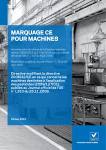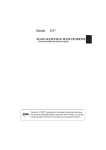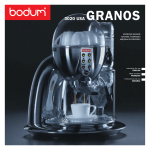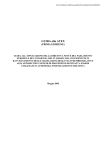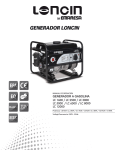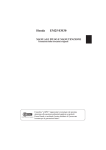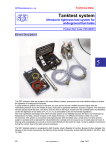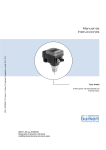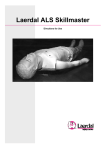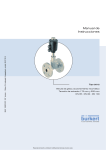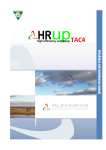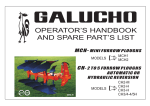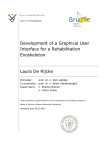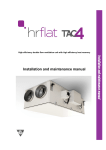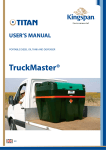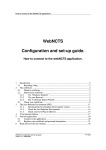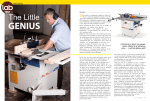Download this file
Transcript
CE-MARKING FOR MACHINERY Adapted to the revised Machinery Directive version 2006/42/EC of 17 May 2006, published in the Official Journal of the EU no. L 157 of 9 June 2006. Correction published in the Official Journal no. L 76 of 16 March 2007. Amendment with regard to machinery for pesticide application (2009/127/EC), published in the EU Official Journal N˚ L310 of 25.11.2009). Edition 2013 YOUR REPUTATION IS MINE. This guide is intended for: To whom does the Machinery Directive apply? • machine builders (including those who build machinery for their own use), • The manufacturer: • designers, engineering consultants, assemblers, • importers, sellers or distributors of machinery, • interested machine users. Put simply, one can say that this is the person who takes responsibility for the conformity of the machine with the Machinery Directive and puts his name on it. This could for example be a design consultant, or the “apparent” manufacturer who purchases machinery in order to place it on the market under his own name. A person who alters new machinery to place it on the market or bring it into use , in principle also has the obligations of the manufacturer. See p.5 and following. Why this guide? • The authorised representative: The (compulsory) CE marking on machinery opens the doors of Europe to you. In exchange for this the European regulations lay certain obligations on you. The natural or legal person that is authorised in writing by the manufacturer to perform all or part of the obligations and formalities intended in the Machinery Directive on his behalf. For this directive the authorised person must be established in the EU (the “Community”) (in practice in the European Economic Area or EEA = the EU plus Norway, Iceland and Liechtenstein). A particular type of authorised person or company is one that is authorised to put together the technical file. See p. 27. The CE marking on machinery indicates conformity with all applicable European directives (or with their transposition into national law) that require such marking. Logically it is the Machinery Directive that contains the most specific requirements for machinery. Nevertheless conformity with the Machinery Directive is not necessarily sufficient and for many machines other directives will also have to be followed. So particularly when one first becomes acquainted with this issue the situation can come over as reasonably complex. • The importer (machinery from outside the EEA) and the seller or distributor (within the EEA): Taking into account and in the light of the experience with revised Machinery Directive 2006/42/EC (1) VINÇOTTE has produced for you this revised edition of the Practical Guide “Machinery” (published for the first time in 1994 and since then distributed in many thousands of copies). Naturally the practical experience obtained in the meantime has also been worked into this new edition. Our intention is in short, in a practical and straightforward way, to set out the various steps that are necessary in order to place on the market or put into service a machine in Europe. The obligations of the manufacturer of the machine also apply to those who build machinery for their own use, without the intention to place them on the market. See among other things p. 28. Directive 2006/42/EC came into force 29 December 2009. It replaces Directive 98/37/EC. ©Vinçotte 2 • The natural or legal person who builds machinery for their own use: ©Vinçotte 1 When neither the manufacturer, nor the authorised person observe the obligations of the Machinery Directive, then these obligations rest on each person who places on the market (or puts into service) the machine within the EEA. See p. 28. 3 YOU ARE A MANUFACTURER The vision of this guide: In view of the relative complexity of the rules concerning CE marking for machinery, and their comprehensive applicability, it is not possible to discuss in detail in a few pages and in a conveniently laid out manner all the possible scenarios that can arise. When drawing up this guide a fairly extensive discussion of the application of the Machinery Directive to a standard machine was decided upon, supplemented by a summary of the interfaces of the Machinery Directive with a number of other directives as they were applicable at the time when this text was drawn up. The reader must however be aware that not all details or specific situations with respect to the application of the CE marking are covered in this approach and that in case of doubt the text of the law is prevailing. Steps for the application of the Machinery Directive to a machine Establishing whether the equipment is a “machine” and whether it comes within the scope of the Machinery Directive. 7 Design and construction of the machine in conformity with the applicable essential (technical) requirements of the directives and the state of the art . In this context also the drawing up of a global “users manual”. 8 Compilation and keeping available for the authorities and / or the notified body of a technical file that demonstrates conformity of the machine with the Directive. 10 This guide always refers to the European directives although they, for their “end user”, are strictly speaking legally valid by transposition into the national legislation of the EU Member States. For Belgium the transposition of the directives discussed here takes place generally in line with the execution decrees of the law of 9 February 1994 “concerning the safety of products and services”. Since this concerns “totally harmonised” legislation the importance of the national transposition is limited in practice to the rules for supervising and curbing infringements. The Belgian transposition of the revised Machinery Directive 2006/42/EC can be found in the Royal Decree of 12 August 2008 (Belgian official journal of 1 October 2008). The amendment relating to the machinery for pesticide application (2009/127/EC) is to be found in the Royal Decree of 13 August 2011 (Belgian Official Gazette 7/9/201). For machinery described in Annex IV: Possible application of the special procedures for assessment of conformity. 14 Putting the CE marking and other information on each machine. 18 The drawing up of an EC declaration of conformity to be supplied with each machine. 18 ©Vinçotte When manufacturing a series: establishing the measures for the conformity of all machinery of the series with the model dealt with in the technical file. ©Vinçotte 4 Note: 5 “Machinery” in the scope of the Machinery Directive (articles 1 and 2) The following types of equipment fall within the scope of the Machinery Directive, referred to further in this guide as “machinery”: • machinery in the strict sense, defined as “an assembly, fitted with or intended to be fitted with a drive system other than directly applied human or animal effort, consisting of linked parts or components, at least one of which moves, and which are joined together for a specific application”. The latter means that the machine itself must be usable in practice, must have a practical function. • Under the entity machinery in the strict sense fall also: • assemblies of machinery or of machinery and partly completed machinery which, in order to achieve the same end, are arranged and controlled so that they function as an integral whole, • machines missing only the components to connect it on site or to sources of energy and motion • machinery ready to be installed and able to function as it stands only if mounted on a means of transport, or installed in a building or a structure (for example a mobile crane or a gantry crane). • machinery exclusively powered by direct human effort but intended for lifting loads. ©Vinçotte ©Vinçotte • interchangeable equipment that is intended to be assembled by the user with a machine or tractor and thereby change its function or attribute a new function. • safety components that are independently placed on the market (so not incorporated in a machine) and are intended by their manufacturer to fulfil a safety function in machinery. These are components that are not necessary for the normal operation of the machine or that can be replaced by normal components in order for the machinery to function. Annex V of the Directive contains a non-limitative list of safety components. • lifting accessories: components or equipment not attached to the lifting machinery, allowing the load to be held, which are placed between the machinery and the load or on the load itself, or which are intended to constitute an integral part of the load and which are independently placed on the market; slings and their components are also regarded as lifting accessories;. • chains, ropes and webbing: chains, ropes and webbing designed and constructed for lifting purposes as part of lifting machinery or lifting accessories. • removable mechanical transmission devices: removable component for transmitting power between self-propelled machinery or a tractor and another machine by joining them at the first fixed bearing. When it is placed on the market with the guard it shall be regarded as one product. In addition the following elements must be taken into account: • article 1.2 of the Machinery Directive contains a list of exceptions to the scope (“machinery” that is excluded from the scope). • pursuant to article 3, directives that cover particular hazards more specifically have priority over the Machinery Directive. See further “Interfaces with other directives”. • The Machinery Directive also applies to “partly-completed machinery” that can not accomplish a particular application 7 independently (in the past called machinery intended to be incorporated into machinery or The details of interpretation and application of the fundamental requirements are left to those involved, with nevertheless a legally regulated preference for the use of the harmonised European standards in the form of a legal presumption of conformity with the corresponding essential requirements. While some of the essential requirements are limited to a couple of lines of text, their application is supported by one or more standards that take up a considerable volume. As for other directives the list of the harmonised standards that give a presumption of conformity with the essential requirements of the Machinery Directive is published periodically in the Official Journal of the European Union. assembled with other machinery). See further for the special rules for this machinery. The essential health and safety requirements (Annex I) This annex is divided into six chapters, preceded by some important “General principles”. The first chapter formulates in a general way the various requirements and is applicable to all machinery. The others deal in a more specific way with the additional health and safety requirements for particular special types of machinery or for particular hazards. These additional requirements apply to the machinery or hazards involved, in addition to the requirements of the first chapter. So for example in addition to chapter 1, a mobile elevator platform will have to comply with chapters 3, 4 and 6. The division of annex I is as follows: General principles. 1. Essential health and safety requirements 2. Supplementary requirements for the food industry, machinery for cosmetics or the pharmaceutical industry, hand-held and/or hand-guided machinery, portable fixing tools and other riveting tools,machinery for working wood and material with similar physical characteristics and machinery for 8 Although not mandatory, the harmonised European standards thus play an important role in the application of the New Approach directives: apart from their use conferring a presumption of conformity and so among other things simplifying the drawing up of the technical file (see below), they after all give a description of the “state of the technique”. This means also that if the manufacturer uses solutions other than those set out in the relevant standard(s), he is nevertheless still expected to be able to demonstrate that with this solution a level of safety is attained comparable with the level obtained when the standard is applied. The manufacturer will in line with his risk assessment have to establish what essential requirements are applicable to his machinery, and whether these are complying in the correct way with defendable solutions. This assessment is greatly simplified to the extent that the machine is designed and built in conformity with the harmonised standard(s). The essential requirements of the Machinery Directive and the harmonised standards Typical of the “New Approach” directives for the free movement of products are the requirements for design and construction of the products formulated as “fundamental” or, as in the revised Machinery Directive 2006/42/EC, “essential” requirements. The intention in doing this is that the legal requirements remain limited to generally formulated objectives that indicate the results to be achieved, without imposing the technical solutions (though this does not detract from some of the requirements being fairly concrete and specific). The harmonised standards for the application of the Machinery Directive are divided into three levels: A.“basic standards” that apply to all machinery (basic concepts, terminology and design principles). B.“generic” or “general standards” that deal with specific safety aspects (B1) or safety provisions (B2) that are relevant for a whole series of machines. ©Vinçotte The machinery to which the Machinery Directive is applicable, must answer to the “essential safety and health requirements relating to the design and construction of machinery”, which constitute the subject of annex I of the directive. pesticide application. 3. Supplementary requirements to offset hazards due to the mobility of machinery. 4. Supplementary requirements to offset hazards due to lifting operations. 5. Supplementary requirements for particular machinery intended for underground work. 6. Supplementary requirements regarding the hazards due to the lifting of people. ©Vinçotte The essential health and safety requirements of the Machinery Directive letters EN, or EN ISO for standards drawn up in conjunction with ISO, followed by a number and the year of issue (e.g. EN ISO 13857:2008). These standards are also included in the catalogue of the national standards institutions (possibly translated) and their European references are preceded by the national identification letters (for Belgium NBN), without the content being changed by this. The A and B standards are also called “horizontal” standards, the C standards “vertical”. The most efficient starting point in the study of the conformity of a machine is, if it is available, the appropriate standard of the C type. Logically it is the manufacturer’s duty to ensure that the people charged with the design and the construction of machinery have access to the current version of the relevant harmonised standards and have a clear understanding of the role and the importance of these standards. For the aspects that are not covered by harmonised standards, where possible other references will have to be sought, such as European design standards (prEN), national and international standards, specialist literature. Logically preference will be given to references that reflect the best state of the technique such as is experienced at present in Europe. Of course use of these do not automatically give a presumption of conformity. For special problems for which there is insufficient competence within the company, it would be appropriate to call in external specialists in the domain involved. C.“machine standards” for the safety of specific machinery or groups of machines. The European standards are indicated by the 9 The technical file: demonstrating the conformity (Annex VII) Basic ideas about the technical file for machinery The “construction file” with respect to the conformity of the model Before placing machinery on the market and/ or putting it into service, the manufacturer shall ensure that a technical file is available. This technical file has to comply with the provisions of annex VII, section A of the Machinery Directive (article 5.1). It must demonstrate that the design and construction of a model of the machine comply with the requirements of the Machinery Directive. To the extent that this is necessary for the assessment of the conformity it must also provide an insight into the design, manufacture and operation of the machine. The elements that must be present in the model’s construction file are summed up in point A.1.a of annex VII. Apart from a number of other elements such as information about the machine, a copy of the instructions for use and the EC declaration of conformity, an essential element of the construction file is undoubtedly the documentation of the risk assessment, from which the procedure followed appears, with inclusion of the following information: 10 • the description of the protective measures implemented to eliminate identified hazards or to reduce risks and, when appropriate, the indication of the residual risks associated with the machinery. In the event that the manufacturer does not wish to make use of the relevant harmonised standard (or if there is no appropriate standard) the case for the “defence” can for example be based on the list of essential requirements. In that case the “defense” of the conformity will normally demand greater effort and in such cases the standard will still have to be used as reference for the state of the technique (see above). The best approach will be, if there is a type C standard, to follow this as much as possible or in any case to use it as reference. For the risk analysis the manufacturer must go through the following steps: • • • • • Define the limits of the machines Check what hazards and hazardous situations may be caused, Estimate the risks Assess the risks so as to decide on the need for a risk reduction or otherwise Eliminate the hazards or reduce the risks. It is important that a good construction file in a systematic and credible way, and with sufficient profundity, demonstrates the conformity of the machine model with the essential requirements of the directive. For a credible demonstration of the conformity with the applicable requirements tests can be used, among other things, . The results of these tests are included in the construction file. When a type C standard is applied, the required tests will normally be stated in the standard. ©Vinçotte Next to the use by the authorities as the basis for assessing the conformity, the technical file, as discussed further, must also be submitted to the notified body for machinery of Annex IV, in the case of an EC type examination according to annex IX, and if the procedure for complete quality assurance is used, according to annex X. • A list of the essential health and safety requirements which apply to the machine involved, and ©Vinçotte The technical file must be made available to the competent authorities of the Member States for at least ten years following the date of manufacture of the machinery or, in the case of series manufacture, of the last unit produced. Not making the file available after a properly justified request from the authorised national authorities can be sufficient reason for doubt about the conformity of the machine with the essential requirements of the directive. If in the design and construction of the machine use is made of a harmonised type C standard, the compilation of above-mentioned essential element becomes a lot simpler: in that case it is sufficient, after establishing that the machine falls within the scope of the standard, to give a description of the way in which the provisions of the standard are used. In some cases the standard does not cover the complete application of the Machinery Directive to the machine. This can then be established on the one hand in the description of the applicability in the standard and on the other hand in the informative annex that indicates the connection between the provisions of the standard and the directive, usually referred to with two letters, beginning with “Z”). In such cases additional action is of course necessary for the essential requirements that are not covered. Deviations from the standard must also be “defended” more extensively. Additional obligations in case of series manufacture Basically the construction file for a machine deals with the conformity of the model, so in fact of one (type) unit, while the manufacturer (or his authorised representative, …) must naturally guarantee the conformity of each unit supplied. In case of series manufacture the technical file must therefore, in addition to the construction file for the conformity of the model, contain a description of the internal measures that have been used to make sure that all copies of the machine remain in conformity with the provisions of the directive. In other words it concerns the measures whose purpose is to keep the manufactured machinery identical to the model for which the file was drawn up. Although not obligatory, the ideal approach to this obligation relies on a certified quality system (EN ISO 9000). In the absence of such a system the manufacturer will have to work out its own measures that ensure a comparable result. In conjunction with this, in practice the problem also arises with the evolution of the model (change of suppliers, small changes in the design, etc.). On the one hand the retention period must be respected for the construction file for the original model, on the other hand the most important thing is that each change must be covered by a supplement to the file or, for fundamental changes, by a new version of the file. 11 • The file does not in principle have to be permanently present in material form (particular drawings can e.g. be held in a drawings archive, in electronic form or on paper). It also does not have to be located within the territory of the EEA. It must 12 • The file must be drawn up in one or more of the official languages of the EEA. So it can e.g. be in Danish, but not in Japanese. An exception to this is the “original instructions for use” a copy of which must be contained in the file. • The file must not necessarily contain all the detailed information about the manufacture of parts used, unless knowledge of them is indispensable for checking the conformity with the essential requirements. ©Vinçotte • The file does not have to be systematically made available to one or another inspection body : it only has to be submitted to the authorities in response to a reasoned request and in some cases, for machinery of annex IV, to the notified body. The Machinery Directive also does not provide that the technical file must be supplied with the machine. however be possible for the person who is authorised to do this in the EC declaration of conformity to assemble it and make it available within a reasonable time frame. ©Vinçotte Some additional rules for the technical file Additional obligations for machinery of annex IV (Article 12.3 and 12.4) The machinery of annex IV For the assessment of conformity of most machinery, namely that which is not named in annex IV of the Machinery Directive, the prescribed procedure is that of an internal check of the manufacture of the machinery, which is known as “self certification”, without the compulsory intervention of third parties. 9. Presses, including press-brakes, for the cold working of metals, with manual loading and/or unloading, whose movable working parts may have a travel exceeding 6 mm and a speed exceeding 30 mm/s. 10. Injection or compression plastics-moulding machinery with manual loading or unloading. However additional rules apply for the assessment of conformity of machinery that is mentioned in annex IV “Categories of machinery to which one of the procedures referred to in Article 12(3) and (4) must be applied”. 1. 11. Injection or compression rubber-moulding machinery with manual loading or unloading. 12. Machinery for underground working of the following types: 12.1. locomotives and brake-vans; 12.2. hydraulic-powered roof supports. Circular saws (single- or multi-blade) for working with wood and material with similar physical characteristics or for working with meat and material with similar physical characteristics, or the following types: 1.1. sawing machinery with fixed blade(s) during cutting, having a fixed bed or support with manual feed or the workpiece or with a demountable energy feed; 1.2. sawing machinery with fixed blade(s) during cutting, having a manually operated reciprocating saw-bench or carriage; 1.3 sawing machinery with fixed blade(s) during cutting, having a built-in mechanical feed device for the workpieces, with manual loading and/or unloading; 1.4. sawing machinery with movable blade(s) during cutting, having mechanical movement or the blade, with manual loading and/or unloading. 13. Manually loaded trucks for the collection of household refuse incorporating a compression mechanism. 14. Removable mechanical transmission devices including their guards. 15 Guards for removable mechanical transmission devices. 16. Vehicle servicing lifts. 2. Hand-fed surface planing machinery for woodworking. 17. Devices for the lifting of persons or of persons and goods involving a hazard or falling from a vertical height of more than three metres. 3. Thicknessers for one-side dressing having a built-in mechanical feed device, with manual loading and/or unloading for woodworking. 18. Portable cartridge-operated fixing and other impact machinery. 4. Band-saws with manual loading and/or unloading for working with wood and material with similar physical characteristics or for working with meat and material with similar physical characteristics, or the following types: 4.1. sawing machinery with fixed blade(s) during cutting, having a fixed or reciprocatingmovement bed or support for the workpiece; 4.2. sawing machinery with blade(s) assembled on a carriage with reciprocating motion. 19. Protective devices designed to detect the presence of persons. 5. Combined machinery or the types referred to in points 1 to 4 and in point 7 for working with wood and material with similar physical characteristics. 22. Roll-over protective structures (ROPS). 20. Energy-operated interlocking movable guards designed to be used as safeguards in machinery referred to in points 9, 10 and 11. 21. Logic units to ensure safety functions. 23. Falling-object protective structures (FOPS). 6. Hand-fed tenoning machinery with several tool holders for woodworking. 7. Hand-fed vertical spindle moulding machinery for working with wood and material with similar physical characteristics. ©Vinçotte 14 ©Vinçotte 8. Portable chainsaws for woodworking. 15 The conformity assessment procedures for machinery of annex IV draw up for each machine his own declaration of conformity (the declaration of EC type examination is limited to the type). • For machinery that completely complies with the recommendations of the harmonised European (type C) standards that cover the whole application of the directive to the machine, the manufacturer has the choice of three possibilities: • To get a “EC type examination” of the machine and the file performed. • The procedure for a complete quality assurance according to Annex X. The declaration of EC type examination must be stored by both parties for 15 years. Every 5 years the notified body must evaluate the validity of the declaration and possibly extend the duration of validity. This is the procedure according to annex IX, by which a notified body establishes and declares that a representative model of the machine intended in annex IV (the “type”) complies with the provisions of the Machinery Directive. The manufacturer must apply for this examination to a single notified body of his choice. He must in doing this make available one specimen of the type for examination, together with his technical file. Upon a positive result of the examination the notified body supplies a “declaration of EC type examination” to the applicant. On the basis of this declaration the manufacturer must then 16 The notified body Notified bodies are designated by the Member States to perform the compulsory interventions on machinery of annex IV: under 2006/42/EC the EC type examination and/or the evaluation of the quality systems and the supervision of the application of these systems. They can be designated for one or more categories of the machinery named in annex IV. The criteria for designating the bodies are laid down in annex XI. The Member States “notify” to the EU Commission and the other Member States what bodies they have designated and for what specific interventions. The bodies are assigned an identification number by the Commission. Although the designation of the notified bodies and the supervision of their operation is national, there is, in contrast to the external services for technical checking, no territorial limitation to the competency of the bodies, and for the compulsory interventions the manufacturer can call on any body notified for the technical field. The declarations or reports supplied are valid in all countries of the EEA. The procedure for complete quality assurance This is the procedure for assessing the conformity of machinery intended in annex IV by means of a system for complete quality assurance, according to annex X. The quality system must refer to the design, the manufacture, the final check and the testing of the machine. In doing this the notified body must evaluate and approve the quality system, and monitor the way in which it is applied. Vinçotte is a notified body for most machinery of annex IV.. The manufacturer must apply for the evaluation of his quality system to a single notified body of his choice. With his application he must make available the documentation of his quality system, as well as the technical file for one model of each of the categories of machinery stated in annex IV that he wants to manufacture. Here too conformity of the quality system with the relevant harmonised standard gives a presumption of conformity. The notified body conducts periodic checks to monitor the way the manufacturer maintains ©Vinçotte The EC type examination for machinery of annex IV The manufacturer must ensure that the machine complies with the state of the technique. He must inform the notified body of all changes made to the type so that the body can judge whether the declaration remains valid. From its side the notified body must inform the manufacturer of all important changes that can have consequences for the validity of the declaration. ©Vinçotte • If the machinery is completely built according to harmonised standards that cover the complete application of the relevant essential requirements to the machine, then the manufacturer has, in addition to the procedures described above, also the option of following the same procedure as for machinery not specified in annex IV, namely the internal check of design and manufacture according to annex VIII (so without intervention of a notified body). and operates the quality system. These periodic checks must be scheduled in such a way that after each period of three years all parts of the system have been checked. The notified body can furthermore make unannounced visits to the manufacturer. 17 The CE marking and the “identification plate” on the machine (Article 16 and annex III) All machinery must, as an external sign of conformity with all applicable directives, bear the CE marking according to the depicted model. This CE label is not supplied by an official body, it must be put by the manufacturer or his authorised representative “visibly, legibly and indelibly” in the immediate vicinity of the name of the manufacturer or his authorised representative and using the same technique, on each machine. A clear link is therefore created between the manufacturer and the CE marking. When machinery of annex IV has passed the complete quality assurance procedure, then the CE marking must be followed by the identification number of the notified body involved. In addition to the CE marking at least the following information must be put on each machine: • The company name and the complete address of the manufacturer and, where applicable, his authorised representative; • The designation of the machine (i.e. the usual name for the machine category to which the specific machine model belongs); • Designation of series or type ; • The serial number, if any; • The year of construction, that is to say the year in which the manufacturing process was completed. The EC declaration of conformity must, in addition to conformity with the provisions of the Machinery Directive, declare conformity with the other applicable directives. If a notified body is involved for a machine of annex IV the declaration must also contain information about the notified body and, in EC type examinations, the number of the EC type examination declaration. New in the revised Machinery Directive 2006/42/EC is that the declaration must contain the name and address (in the EEA) of More information may be required when the machine is intended to be used in a potentially explosive environment, or other information that is necessary for safe use. When a component of the machine has to be moved with hoisting or lifting equipment while it is in use, the weight of this component must also be stated. Some of the type C standards contain provisions concerning this additional information. In the directive 98/37/EC (as amended by 98/79/EC) partly completed machinery was defined as “machinery intended to be incorporated into machinery or assembled with other machinery, except where it can function independently “ The legal obligations of the manufacturer of such machinery were limited to supplying it with a declaration, the essential element of which was a ban on putting it into use before the whole machine into which it was built or the other machine into which it was incorporated was brought into conformity with the provisions of the directive. ©Vinçotte This declaration naturally concerns the machine in the condition in which it is placed on the market. The manufacturer or his authorised representative must retain the “original declaration” until at least 10 years after the last date of manufacture of the machine. ©Vinçotte 18 machine into the language area concerned. t is worth noting that the same language requirements apply for the manual that has to be provided with the machine. Details of the content of the EC declaration of conformity are given in annex II.1.A of the Machinery Directive. The person who accepts the duty of signing the declaration should, if he himself is not responsible for designing and constructing the machine, at least check that there is a reasonable likelihood, confirmed by a correct file, that the machine complies with the essential requirements of the directives. (Article 13) (Annex II.1.A and II.2) The “original declaration” must be drawn up in one or more official language(s) of the EEA. When an “original declaration” in the official language or languages of the country of destination is lacking, a “translation of the original declaration” into that language or languages must be provided by the manufacturer or his authorised representative, or possibly by the person who introduces the In addition it must mention the place and date on which the declaration was made. Obligations for partlycompleted machinery The declaration of conformity Every machine when placed on the market and/or put into service must be accompanied by an EC declaration of conformity, drawn up by the manufacturer or his authorised representative. the person who is authorised to draw up the technical file. The basic definition of such machinery that can not function independently has not changed substantially, but the revised directive 2006/42/EC speaks of “partlycompleted machinery”. At the same time the obligations for placing partly-completed machinery on the market have been extended. They include in broad terms the following: • The drawing up of a technical file according to annex VII.B. This file is somewhat comparable to that for machinery, but specifically demonstrating the conformity is limited to those essential requirements that are stated by the manufacturer in his declaration as being fulfilled. • The supply of the partly-completed machine with a “declaration of incorporation” according to annex II.1.B. In addition to the earlier “ban on putting into use” which remains, among other things it is specific to this declaration that the manufacturer must state what essential requirements of the Machinery Directive have been applied and complied with and moreover that he undertakes to give the required relevant information about the partly-completed machine to the authorities. 19 • The supply with the partly-completed machine of “assembly instructions” to ensure correct assembly. These instructions must be drawn up in an official language of the EEA that is acceptable to the purchaser. requirements for which fulfilment does not depend on the assembly or building in, and • that the manufacturer supplies a user’s manual that as much as possible deals with all aspects of bringing the partly-completed machine into service. The declaration of incorporation and the assembly instructions must be included in the technical file for the assembled machine. Compliance with all essential requirements that are not included in the declaration of incorporation must obviously be guaranteed by the purchase of the partly completed machinery.The purchase of a partly completed machine is therefore never the end of the story. So although the obligations of the manufacturer of the partly-completed machine have been extended to an important extent, it remains important for the purchaser (who will have to sign a declaration of conformity for the assembled whole) to agree by contract: • that the manufacturer as much as possible declares conformity with all essential ©Vinçotte ©Vinçotte Assembly of machines and construction of complex installations In many cases machinery is assembled, or complex installations are tailor-made by the user, starting with purchased machinery or partly-completed machinery. The responsibility for the project can then for example rest on the client, the supplier of (part of) the basic machinery, an engineering consultant, etc. In general for the application of the Machinery Directive the assembly must be treated as a “normal” machine, in which “someone” will have to act as manufacturer, with responsibility for the conformity, for compiling the technical file, drawing up and signing the overall declaration of conformity, affixing the CE marking, etc. The status of a being an assembly is subject to compliance with the following criteria: • the assembly serves a common purpose, such as the manufacture of a specific product; • the assembled machines are functionally connected in such as way as to create potential risks so a risk assessment is required for the whole assembly; • the assembly has a common control system. In such situations the client is advised to pay attention in particular to the need: • To establish at the start of the project who will be “manufacturer” in the sense of the Directive. • To the extent to which the conformity of the purchased or partly-completed machinery is guaranteed, the work of the “final manufacturer” can be simplified. Particular attention must be paid to this in purchasing partly-completed machinery (see above). 21 Relation between the Machinery Directive and other directives Pursuant to article 1.2.k) of the Machinery Directive this directive may therefore be used in place of the Machinery Directive for particular electrical machinery, such as household appliances that are intended for private use. Electrical low voltage equipment from other machinery must, on the basis of the essential requirement 1.5.1 of annex I of the Machinery Directive, comply with the technical requirements of the Low Voltage Directive, but not with its obligations regarding assessment of conformity (so the Low Voltage Directive does not have to be mentioned in the EC declaration of conformity). Directive 88/378/EEC on the safety of toys On the basis of article 3 of the Machinery Directive the latter is not applicable to machinery that falls within the scope of the Toys Directive. Directive 89/686/EEC relating to personal protective equipment (PPE) On the basis of article 3 of the Machinery Directive the latter is not applicable to machinery that falls within the scope of the PPE Directive. 22 2 3 On the basis of article 3 of the Machinery Directive the latter is not applicable to machinery that falls within the scope of the Medical Devices Directive. Hereby it should be noted that article 3 of the amended Medical Devices Directive specifies that all relevant essential requirements of the Machinery Directive that do not appear in the Medical Devices Directive are applicable. Directive 94/9/EC concerning equipment and protective systems intended for use in potentially explosive atmospheres (ATEX “100” Directive) The ATEX “100” Directive applies, for the explosion risk, to machinery intended to be used in a potentially explosive environment, including the electrical equipment of this machinery. In this case the manufacturer of the machine will have to draw up an EC declaration of conformity with the Machinery Directive and the ATEX “100” Directive. The reference to “the specific community directives” in essential requirement 1.5.7 of annex I of the Machinery Directive must be understood as a reference to the ATEX “100” Directive. Directive 95/16/EC concerning lifts On the basis of article 3 of the Machinery Directive the latter is not applicable to lifts and safety components that fall within the scope of the Lifts Directive. Hereby it should be noted that section 1.1 of annex I of the Lifts Directive specifies that all relevant essential requirements of the Machinery Directive that do not appear in the Lifts Directive are applicable. The ATEX “100” Directive is not applicable to zones within a machine where a potentially explosive environment can exist (and neither to an explosion risk that exists under other than atmospheric conditions). In this case the hazards will be covered by essential requirement 1.5.7 of the Machinery Directive. The Machinery Directive also applies to lifts that are excluded from the scope of the Lifts Directive insofar as they are not also excluded from that of the Machinery Directive. Directive 2000/9/EC relating to cableway installations designed to carry persons For machinery already on the market a machinery manufacturer can incorporate into the machine ATEX appliances, protective systems or components against the explosion risk. In that case the EC declaration for the machine does not have to refer to the ATEX Directive, but the declarations of conformity of the appliances, systems or components is to be included in the machinery manufacturer’s technical file. On the basis of article 3 of the Machinery Directive the latter is not applicable to cableway installations designed to carry persons that fall within the scope of the Cableways Directive. The Machinery Directive is on the other hand applicable to some of the cableways excluded from the scope of the Cableways Directive (for example cableways exclusively for goods and cableways for agriculture, mining or industrial use). Other installations excluded from the scope of the Cableways Directive are also excluded from In principle this overview only gives references to the basic directives, not to any Directives that amend these basic directives. Overview based on the draft commentary on the Machinery Directive 2006/42/EC. ©Vinçotte Directive 2006/95/EC relating to electrical equipment designed for use within certain voltage limits (Low Voltage Directive) that of the Machinery Directive (for example as means of transport for transport over water and over railway tracks). Directive 93/42/EEC concerning medical devices (amended by 2007/47/EC) ©Vinçotte Below are stated a number of EU directives that can be important for machinery (2)(3). At the same time the principal relation between these directives and the Machinery Directive is also stated briefly. Directive 84/500/EEC, Regulation (EC) No. 1935/2004, Directive 2002/72/EC relating to materials and articles intended to come into contact with foodstuffs The requirement 2.1.1(a) of annex I is a reminder that materials that are intended to come into contact with foodstuffs have to comply with “the directives concerned ”. This reference must be understood as a reference to Directive 84/500/EEC, Regulation (EC) no. 1935/2004 and Directive 2002/72/EC. Directive 87/404/EEC relating to simple pressure vessels The Simple Pressure Vessels Directive applies, for hazards regarding pressure, to pressure vessels within its scope that are built in series and that are built into or connected with machinery. If simple pressure vessels that have already been put on the market, are built into a machine, then the machine manufacturer’s technical file must contain documents that confirm the conformity of the pressure vessels with the Simple Pressure Vessels Directive. Requirement 3.1.2 of annex I of the Machinery Directive covers the risk of breakage during use of parts when this risk is not covered by the specific Directive. 23 The Directive also applies, for the hazards covered thereby, to appliances within its scope that are built into machinery. If appliances burning gaseous fuels that have already been placed on the parket are built into machinery, then the documents with regard to the conformity with this Directive must be added to the machine manufacturer’s technical file. Appliances that are intended specifically for use in industrial processes and are used in industrial companies, fall outside the scope of the Directive and so are subject to the Machinery Directive if they fall within its scope or are built into machinery. The Machinery Directive also applies to appliances burning gaseous fuels with moving parts that fall within the scope of the Gas Appliances Directive, for hazards that are not covered by the latter Directive. Directive 97/23/EC concerning pressure equipment The Pressure Equipment Directive applies, for hazards that are the result of pressure, to the pressure equipment within its scope, that forms part of, or is connected with, machinery. If pressure equipment that has already been placed on the market is built into machinery, then the documents with regard to the conformity with this Directive must be added to the machine manufacturer’s technical file. 24 Pressure equipment that falls under category I at the highestx&, that is built into machinery within the scope of the Machinery Directive, is excluded from the scope of the Pressure Equipment Directive. So in this case the Machinery Directive applies in full to such equipment. Directive 89/106/EC concerning construction products The Construction Products Directive applies, in addition to the Machinery Directive, to machinery intended to form an enduring part of buildings or constructed works (such as powered gateways, doors, windows, blinds and screens, systems for ventilation and air conditioning). This Directive is only applicable however to products for which a harmonised technical specification is available. Directive 97/68/EC (amended) relating to measures against the emission of gaseous and particulate pollutants from internal combustion engines to be installed in non-road mobile machinery This Directive applies to the emission of gaseous and particulate pollutants from internal combustion engines to be installed in non-road mobile machinery within its scope. ©Vinçotte This Directive applies to appliances burning gaseous fuels that are used for cooking, heating, hot water production, refrigerating, lighting or washing, including fan-assisted gas burners, and to equipment for such appliances. Requirement 3.1.2 of annex I of the Machinery Directive covers the risk of breakage during the use of parts when this risk is not covered by the specific Directive. ©Vinçotte Directive 90/396/EEC relating to appliances burning gaseous fuels This Directive applies to the radio equipment within its scope that is built into machinery (such as radio control). If radio and telecommunication equipment that has already been placed on the market is built into machinery then the technical file of the machine manufacturer must contain the documents with regard to the conformity of this equipment with the Directive. It should be noted that the safety of remote control systems is subject to the Machinery Directive. 26 The RoHS Directive applies to electrical and electronic equipment of the categories 1, 2, 3, 4, 5, 6, 7 and 10 of annex I A in Directive 2002/96/EC (WEEE). Note: Directive 85/374/EEC (amended by 1999/34/EC) concerning the liability of the manufacturer for defective products is not Some of the products of these categories can also fall within the scope of the Machinery Directive, such as for example, categories 1 – large household appliances not intended for domestic use, 6 – electrical and electronic tools, 7 – powered equipment for sport and leisure, and 10 – automatic dispensers. Acting as the machine manufacturer’s authorised representative assumes the following elements: Directive 2004/108/EC relating to electromagnetic compatibility This Directive applies, regarding emission of noise, to machinery intended for use outdoors, that falls within its scope. The last paragraph of requirement 1.7.4.2.(u) of annex I of the Machinery Directive specifies that the requirements of Directive 2000/14/ EC regarding measuring the sound pressure or sound power level are applicable to the The Machinery Directive deals with the immunity of machinery regarding electromagnetic disturbances of importance for safety, transmitted by radiation or along conductors. directly related with for example the Machinery Directive. In contrast to the Machinery Directive, the transposition of which comes under criminal law, this Directive comes under civil law. It regulates the compensation of the victim in accidents as the consequence of defects in the product (“objective liability” of the manufacturer). Naturally the correct application of the Machinery Directive will indeed reduce the chance of an accident and thereby the likelihood of a damages claim. YOU ARE THE MANUFACTURER’S AUTHORISED REPRESENTATIVE The restrictions of the RoHS Directive regarding the use of dangerous substances apply to such products. The EMC Directive applies, in addition to the Machinery Directive, to machinery that contains electrical or electronic equipment and that is capable of causing electromagnetic disturbances, or the performance of which is susceptible to being affected by such disturbances. The Directive covers aspects of EMC with regard to the operation of the machine. Directive 2000/14/EC relating to the noise emission in the environment by equipment for use outdoors The Energy-using Products Directive establishes a framework for requirements regarding the ecodesign of industrial products. The measures to be applied in this context can be applicable to machinery or to equipment intended for building into machinery. Directive 2002/95/EC on the restriction of the use of certain hazardous substances in electrical and electronic equipment (RoHS) • an express agreement with the manufacturer regarding the obligations of the manufacturer that will be fulfilled by the authorised representative, • the authorised representative is established in the EEA, • the contracted obligations in the context of the application of the Machinery Directive are performed by the authorised representative. ©Vinçotte Directive 1999/5/EC on radio equipment and telecommunications terminal equipment Directive 2005/32/EC regarding ecodesign for energy-using products machinery within its scope and that in that case the corresponding provisions of the requirement no longer apply. ©Vinçotte Engines installed in non-road mobile machinery must bear the marking intended in article 6 and described in section 3 of annex I of the Directive, but this Directive does not have to be mentioned in the declaration of conformity with the Machinery Directive. The machine manufacturer’s technical file will however contain the documents with regard to the conformity of the engine installed in the machine with the Directive. The role of authorised representative means the acceptance of an important responsibility. Therefore we advise any interested parties to take some elementary precautions before committing themselves to this role. These precautions consist particularly in establishing precisely in writing the rights and obligations of each of the two parties. Depending on the nature and the extent of the tasks delegated by the manufacturer, among other things the following aspects will have to be looked at in the contract: • the execution of possible technical modifications to the machine, if these are necessary for conformity, • the supply of the necessary technical documents for the compilation of the technical construction file, • the informing of the authorised representative of every change that the manufacturer makes in the machine, • on the assumption that the authorised representative acts as importer or distributor, the distribution of the costs incurred if the manufacturer appoints additional distributors or importers. For the obligations on the technical level we refer to the previous chapters. 27 YOU ARE AN IMPORTER OR SELLER DO YOU NEED HELP IN APPLYING THE MACHINERY DIRECTIVE? The CE marking has the advantage that at present the legal requirements concerning the design and construction of machinery are identical in all countries of the EEA. As an importer or seller you are nevertheless advised to consider a number of elements. External help can be obligatory for machinery of annex IV. In addition external input can be the solution in the absence of sufficient manpower, if you yourself are too still developing the necessary expertise, for commercial reasons… In the first instance it is important for you not to conclude any agreements for the supply of machinery, without being certain that this machinery will have the CE marking and an EC declaration of conformity. If not you run the risk of yourself being landed with (some of) the problems. In principle you could then naturally consider acting as authorised representative, as discussed above. If the manufacturer guarantees that his machinery comply with the applicable European directives, then it would be advisable to display reasonable prudence principally in connection with the following aspects: • the presence of a correct CE marking and an identification plate on each machine (bearing the name and address of the manufacturer). • the supply of each machine with a correct declaration of conformity. You can approach VINÇOTTE for expert and efficient help in just about all aspects of both the application of the Machinery Directive and the CE marking on machinery. Our long experience and our approach, among other things periodically assessed in the context of our accreditation as notified body for the Machinery Directive and various other directives, are our guarantee of the quality of this help. • the presence of the user’s manual that contains all large elements provided for by the applicable directive(s), in the original language with if necessary translation into the language(s) of the country of destination. • the absence of striking risks or designations of non-conformity (that can be observed without consulting the technical construction file). Typical examples of assistance are: • in the event that the machine appears in annex IV of the Machinery Directive, possibly an appropriate intervention by a notified body for the domain involved. • Intervention as a notified body for most machinery of annex IV (EC type examination, complete quality assurance system). • Voluntary certification of the conformity in cases in which the intervention of a notified body is not mandatory. • Exploratory study of the application of the CE marking in a project: applicable directives and situating the equipment within these directives, the various obligations, the relevant standards, etc. • Help in the design concerning application of the essential requirements and the relevant standards. • Help in drawing up the user information. • Help in the conformity assessment procedure: technical file, EC declaration of conformity, markingl, declaration for partlycompleted machinery. • Help in drawing up the purchase order for partly-completed machinery and/or in assessing the conformity guarantees received from the manufacturer. • Information about legislation and standards, and the interpretation of these. • Supervision of the coordination of projects for incorporating into another machine or complex installations. YOU ARE CONSTRUCTING A MACHINE FOR YOUR OWN USE ©Vinçotte 28 In addition to the obligations as manufacturer of the machine you must naturally also comply with the rules that are directed towards the machine user / employer (see our Practical Guide “Work equipment / machinery”). ©Vinçotte In principle the obligations concerning CE marking apply in full to everyone who builds a machine for his own use or who incorporates machinery and/or parts of machines into another machine for his own use. 29 WHERE TO FIND MORE INFORMATION? Particular directives or Official Journals of the EU (for example looking up the consolidated text in one of the EU languages searching by the basic directive number): www.eur-lex.europa.eu Belgian legislation: Belgian Statute Book or specific legislation including the Belgian transposition of directives: www.just.fgov.be www.economie.fgov.be The most recently published Official Journals of the EU: www.eur-lex.europa.eu To order standards: www.nbn.be Standards can also be inspected at the Standardisation Bureau NBN, Brabançonnelaan 29, 1000 Brussels. The text of the New Approach directives, the lists of the associated harmonised standards, plus the link to the specific sites for particular directives: www.ec.europa.eu Services provided by Vinçotte: www.vincotte.be On the specific sites there are also usually any guides to the application of the directive, links to the lists of notified bodies, etc. Vinçotte is at your service for all questions about legislation, obligations and evaluations on CE-marking for machinery. Contact our Product Managers Machinery : Marc Vanderhaeghe T: 0479 790 233 E: [email protected] Koen Chielens T: 0479 790 118 E : [email protected] For “certification Annex IV machinery” : ©Vinçotte ©Vinçotte Koen Chielens T: 0479 790 118 E : [email protected] Reproduction allowed with clear imputation of the source 31 Responsible editor : Kurt Gutschoven, Jan Olieslagerslaan 35, 1800 Vilvoorde, Belgium CONTACT Vinçotte Operational headquarter Jan Olieslagerslaan 35 1800 Vilvoorde Belgium Tel: +32 (0)2 674 57 11 Fax: +32 (0)2 674 59 59 Email: [email protected] Or contact our regional offices : Antwerp • Gembloux • Ghent • Hasselt • Loncin • Roeselare • Wijnegem 3 www.vincotte.be

















